I have interacted with a sizeable number of people who think and believe that these two eastern Africa safari destinations – Kenya and Tanzania – are slightly overrated when it comes to the type of safari experience they deliver. This is especially when compared to the southern part of Africa. It is largely a matter of opinion and personal preference.
Opinion and preference notwithstanding, as safari destinations, Kenya and Tanzania offer an amazing combination for an African wildlife safari. We can argue about specific aspects of what makes a good safari, but the consensus is that one would still enjoy a memorable safari whether in individual countries, or combining both countries. As long as it is planned well.
Designing Your Kenya and Tanzania Safari itinerary
Table of Contents
If you are considering combining the 2 safari destinations, on an average budget safari, traveling by road between the parks and reserves, you are well-advised to put aside about 12 to 14 days at the minimum to allow you enjoy a well-designed Kenya-Tanzania safari program. You would, however, be able to visit more parks and reserves with the same number of days if you can afford to fly between some destinations.
Travel By Road – Safari Vehicles Used in Kenya and Tanzania
There are different types of vehicles used on safari in Kenya and Tanzania – open-side jeeps, closed-side land cruisers (or land rovers), and micro vans (sometimes referred to as mini-bus).
The Open Side Safari Vehicles
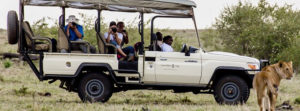
open-side safari jeep
At the top end of the safari vehicles in Kenya and Tanzania is the open-side safari vehicle. They will have a canopy on the top to protect you from the sun (and rain!). This is the type you will likely use if flying into your luxury camp. As the name suggests, they are open on both sides, making them ideal for game viewing, photography, bird-watching while offering an intimate and real connection with the African wilderness. The open side vehicles, though highly recommended, are not suitable for long transfer drives and travel from one destination to another as there is not protection against dust and other elements.
Closed Safari Jeeps, 4×4 Land Cruisers and Land Rovers

Closed-side Toyota land cruiser safari vehicle
If you choose to travel by road instead of flying in, many mid-range operators use these vehicles to transport clients from one park to another, being closed on the sides, they insulate the travelers from the weather elements. They are closed vehicles with a viewing pop-top roof hatches or retractable open that allows you to see outside while standing. These safari vehicles are normally available on a private, one-party basis, and are therefore ideal for those wishing to be alone with family and friends.
The 9-Seater Micro Bus or Safari Van
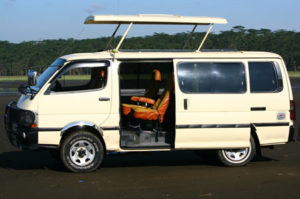
Safari micro Van
The safari van is not for everyone but certainly the economic way of getting around. This type of safari vehicle is mostly used in Kenya and less in Tanzania. By and large, these safari vehicles are mainly booked through tour companies that organized mid-range and budget safaris.
It is important to pick your safari vehicle carefully as it determines the quality of your safari. If you are on a private guided tour of both Kenya and Tanzania, you will have a private vehicle with a guide who will take you on safari in either country and eventually at the border point, from which point you will meet with a new guide with from the other country taking over.
Travel By Air From Camp to Camp
Flying between the destinations provides convenience, saves time and offers relative comfort. It is considered the most efficient mode of transport while on safari.
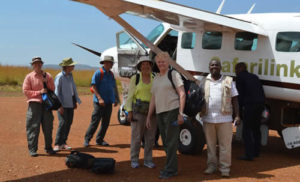
There is hardly any national park, reserve or conservancy in Tanzania or Kenya that cannot be reached by Air. A few select companies offer both schedule flights and private charter services that fly to these parks, starting from the major tourist hubs. For Kenya, that would be Nairobi and Mombasa. Flight safaris in Tanzania begin from Arusha and Dar es Salaam.
Safari flights in East Africa are mostly done using small light air crafts – between 2 seats and 20 seats. As you can imagine, these being smaller planes, there will be weight restrictions for baggage, usually approximately 12 kg (about 26 lbs) for the smallest planes. In fact, for the trip to the bush, it is strongly recommended that luggage is limited to one piece per person. A small overnight bag is more than you would actually need. And most city hotels provide secure storage for left luggage.
Flying Between Masai Mara and Serengeti
Masai Mara and Serengeti still command a huge interest when it comes to safaris. Until very recently, if you were in the Mara, and needed to get to Serengeti quick and fast, you had to fly back to Nairobi, connect a flight to Arusha, then connect again to Serengeti. The same applied the other way round – from Serengeti into Masai Mara. This flight arrangement and connection took well over 8 hours, given the various stops in the multiple airstrips along the way. This duration was more or less the same about of time needed for travel by road -only slightly less tiring. Beginning 2013, some airlines started offering ‘direct’ flights between Kenya’s Masai Mara and Tanzania’s Serengeti. Suffice to say, one can now fly between Serengeti and Masai Mara.
Choosing Your Accommodation For The Safari in Kenya and Tanzania
Hotels, safari lodges and tented camps in East Africa provide world class lodging. The rooms have proper beds with mattresses and duvets, en suite flush toilets, basins and showers with hot and cold running water. They also have amenities that include mosquito net, lamps, purified water, insect repellent, flashlights and wardrobes. Some safari hotels even have presidential suites, with Jacuzzi and swimming pool. Selecting the safari accommodation to use for your holiday is a big consideration. The choice is wide from concrete wall lodges to classic out of Africa camps. The prices vary accordingly – from US$80 per night at the lower end to us$900 per night towards the top end.
The Great Wildebeest Migration Serengeti – Masai Mara
Nobody has ever been able to determine the exact timing and and route of the great migration between Kenya and Tanzania’s Serengeti and Masai Mara. It changes from year to year, and depends on the rains. But you still need a guideline. Fair enough.
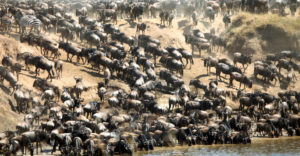
In the period between January and February, the annual rains fall on the Serengeti, in Tanzania, allowing the female wildebeest to give birth to young ones, in the southern plains of the Serengeti.
By March or April, the area has dried out in southern Serengeti and this area then becomes desolate again. So the herds are forced to move northwards towards Lake Victoria where they begin the mating season. After this, they head towards the Masai Mara in June or July and this is where most people witness the sight of thousands of animals galloping across the plains and crossing the notoriously, crocodile-infested Mara River.
River crossings are best seen between July and September. The animals cross back and forth between the two areas during this time. In September, the animals cross back into the Serengeti. After September, there is still a tail end of the migration which lags behind the main herds. If you are late, you can still hope to catch the last of them. The animals then go back to the Serengeti plains from where they started at the beginning of the year.
In Tanzania, the best time to witness the migration is divided between two different periods. In the Southern Serengeti it is in February and March – for the calving. The animals are grazing and can be seen in their immense numbers. In contrast, river crossings are best seen between July and September in the northern part of the Serengeti.
Best Value Wildlife Areas in Kenya and Tanzania
Some of the better known wildlife areas – parks and reserves – in East Africa have over the years become sort of mass tourist destinations. For the traveler seeking exclusive and authentic on safari, there are some treasure troves that still hold riches of African wildlife. Singita Grumeti and Selous are such in Tanzania, while Kenya’s hidden gems are found in some of conservancies bordering Masai Mara, such as Naboisho and Laikipia plains, stretching from the south east of Mount Kenya.
Best Value Safari Lodge for Honeymooners
Are you looking for excitement, privacy and adventure in Kenya? Loisaba Tented Camp would be the answer. The lodge is located on the northern edge of the Laikipia plains, in 61,000 acre wilderness area and a working cattle ranch. Loisaba Tented camp is perched a few hundred feet above a waterhole frequented by a constant stream of wildlife.
Lamai Serengeti of Tanzania has just 12 rooms. These are split between 2 entirely separate lodges, the Main Lodge of 8 rooms and the smaller Private Lodge of 4 rooms. The location is just a few miles from where the wildebeest cross the Mara River. For roughly a quarter of the year, between late July and October, this is the home of the wildebeest migration.
Best For Families Traveling With Children
When traveling as a family, with children, mostly likely you will need hotels and lodges that take care of that aspect. Chem Chem Lodge in Tanzania is an ideal choice. The lodge boasts 8 stylish, secluded tent-style suites have been exquisitely decorated to offer 5-star accommodation. Each tent has spectacular, private lake views measuring (100m²), and created from a combination of canvas, lava-stones and wood. Tents are set at a minimum of 80 metres apart to ensure complete privacy. The family suite consists of a full suite connected to a vintage-style tented room (50m²) with two single beds, a rocking chair, small desk, with its own bathroom (indoor shower) and dressing room. The two rooms are built on the same platform and are connected via a small wooden bridge. The children’s room can take up to 4 children.
Another family friendly lodge is the Saruni Samburu Lodge. The lodge is located in over 200,000 acres of unspoiled wilderness teeming with wildlife. There are 6 cottages in total here, all unique in their design and built into the rock to blend into the surroundings. There are 2 individual villas, with either a double or twin beds, as well as 4 family villas, each containing 2 en suite bedrooms with a shared lounge.
Best Time For Your Kenya- Tanzania Trip – The climate
If there is a perfect climate in the world, surely it is in East Africa with cool mornings and warm mid days. Although it can be hot and sticky by the sea, inland the air is dry and even at midday the temperatures are equitable. Due to the proximity to the equator, sunrise occurs daily between 06.00hrs and 06.30hrs while sunset takes place 12 hours later. It can get quite chilly in the early morning and evening hence visitors should pack a sweater. Each time of year has its special attractions.
There are two main rainy seasons – usually mid-April to the end of May and November to mid-December. Even during the rains, the weather can be pleasant with rain occurring in the early morning and late in the afternoon or evening. If you travel during the rainy season, insist on using 4WD vehicles for your overland travel between the night-stops.
—————————————————–
The author, Levis is the Editor and Safari Consultant at Hallmark Travel Planners. This is a tour operator and Safari Outfitter that specializes on African Travel and holidays. The company, through the website has guided thousands of travelers to achieve their dream holiday. For more information and guidance on Safaris, contact them here.



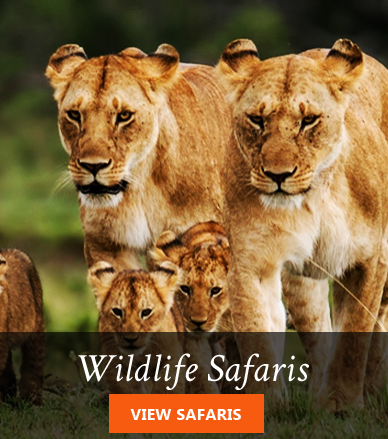
Leave a Reply